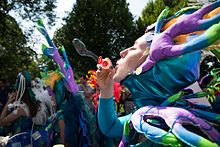Bielefeld Carnival of Cultures
The Carnival of Cultures is a festival for togetherness and creative development in society, for equality, dialogue and recognition. The actors let their everyday personality disappear behind the mask, switch to a counter-world, experiment with roles. The viewer is also involved. The Carnival should break up encrustations, in the best case even initiate social problem solutions. The actors come from all areas of society, from associations, schools, kindergartens and other institutions, from the free music, theater and dance scene. Inclusive groups, intercultural groups, children and young people present themselves at the Carnival of Cultures and implement their ideas and the dream of recognition and a different, livable world.
The carnival is also an act of political will, the desire for social acceptance and togetherness. With the hybrid cultural form of Carnival, hierarchies are to be softened and a physical coldness and distance are to be replaced by joie de vivre, feelings of happiness, creative forms of action, courage to approach and touch other people.
An international festival of tolerance and international understanding, a parade of masks, costumes, fantastic installations and penetrating rhythms: the Bielefeld Carnival of Cultures has been transforming the image of the city year after year since 1997. With around 2,000 actors in around 70 groups from the region, Germany and abroad and around 100,000 spectators on the streets, the Bielefeld Carnival of Cultures is a sensual experience that unites and inspires people across all generations. The peaceful coexistence of different cultures and arts from East Westphalia-Lippe and the whole world promotes an open understanding of an urban living space. With great commitment and complexity, the actors and organizers make a contribution to make the world a little more open. The Carnival, which is organized by the Shademakers Carnival Club and the Welthaus Bielefeld, has developed in recent years into a living testimony to the tolerance, cultural diversity and interculturality of Bielefeld.
history
In 1954 trade unionists founded an association in England to guarantee that friends would no longer be at war with one another. Over the years it has mainly been official delegations and friendship societies that have maintained relations. In the 80s, artists from Bielefeld and Rochdale began to liven up exchanges with young people. The establishment of the artist group AFTER (Artists for the Environment in Rochdale) was a significant factor in the continuation of the cultural exchange between the two cities.
In 1990 Paul Mc Laren founded the Shademakers association in Manchester with a focus on art projects in urban living spaces and the collaboration of professional artists and laypeople. The conventional form of presentation of art , as well as in museums or galleries, bored him more and more. Instead, he turned his attention to the street, where a wider and more brutally demanding audience could be encountered. In 1993 the first meeting between Uschi Dresing and Paul Mc Laren took place, which in 1995 led to the establishment of Shademakers Bielefeld.
In September 1994 Shademakers used the opportunity to present their large costumes as a German-English formation at the “Carnival King and Queen of the World Competition” as part of the second largest carnival in the world in Trinidad's capital, Port of Spain .
1995 began the decisive phase of the concept development for the later Carnival of Cultures. Whitsun 1996 Shademakers took part in the 1st Berlin Carnival of Cultures. An exchange of information between Bielefeld and the organizers of the Berlin Carnival began and only six months later the invitation followed to the first Carnival of Cultures 'network meeting' in the Berlin Workshop of Cultures, in which artists and organizers of similar events from all over Europe took part. After numerous preliminary discussions, suitable event partners were found in Bielefeld, with the cultural office and the Welthaus. After further meetings and discussions, the cultural office joined as a co-organizer. On June 14, 1997 at 4 p.m. the parade started with 32 participating groups, 800 actors and 15,000 spectators in the west of Bielefeld. The first Carnival of Cultures in North Rhine-Westphalia had begun.
literature
- Uschi Dresing: Play Mas. Carnival of Cultures . Kerber, Bielefeld 1997, ISBN 3-924639-81-7 .
- Shademakers Carnival Club (Hrsg.): 10 years Bielefeld Carnival of Cultures. Sometimes biting . Bielefeld 2006, ISBN 3-926882-15-8 .

